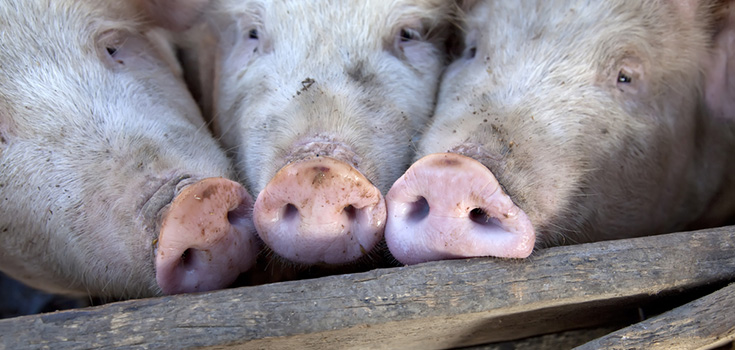Factory Farms Produce 100 Times More Waste than U.S. Population

If you thought you were a major contributor to pollution, just wait until you hear this. Factory farms produce 100 times more waste than every single person in the United States combined. The amount of waste produced by these factories is in such mass quantities that it is virtually impossible to clean up properly. Much of this waste is dumped into the water supply, drastically increasing overall water pollution as well as contributing to the pollution found in drinking water.
Back in 2008 the Environmental Protection Agency (EPA) made a decision that affected many factory farms. They stated that any confined animal feeding operation (CAFO), also known as factory farms, “designed, constructed, operated, and maintained in a manner such that the CAFO will discharge” animal waste must apply for a National Pollutant Discharge Elimination System (NPDES) permit under the Clean Water Act. The livestock industry ridiculed this notion.
There have been past rulings concerning this issue that forced farmers to have a permit to discharge waste and to have a set plan as to how the waste would be discharged, or they would face civil or criminal penalties. The 2008 ruling went further with the issue, putting even more criteria in place to follow.
A ruling on Tuesday, March 15, 2011 by the Fifth Circuit Court of Appeals, however, ruled that the EPA has no right to require CAFOs to apply for permits unless they actually discharge waste. But if a CAFO does in fact discharge waste, the EPA can then require that CAFO to apply for a permit.
Nutrients in animal waste cause something known as algal blooms, which use up oxygen in the water and effectively cause a lack of oxygen for aquatic life to survive. These lifeless areas are called “dead zones”. The most notorious of dead zones can be found in the Gulf of Mexico, where it extended a record 8,500 square miles during the summer of 2002 and stretched over 7,700 square miles during summer of 2010, and is always fluctuating. Ammonia, a toxic form of nitrogen released during waste disposal, can be carried via air over 300 miles before being dumped back onto the ground or into the water, where it causes algal blooms and fish kills.
The past laws set in place forced CAFOs to apply for a permit and create a plan to handle the massive amount of waste the animals would inevitably generate. With this law changing and lowering the standards at which factory farms are run by, CAFO’s will be able to wait until the last minute before they decide to dump the waste. Despite the fact that the EPA will be able to penalize them for such actions, the CAFO’s will already have done the damage to the environment by ridding their land of millions of gallons of manure.
The simple fact is that factory farms are causing problems, and are still being widely used today.
- The number of hog farms in the United States has dropped from 650,000 to 71,000 over the past 30 years, however, the number of hogs remains nearly the same.
- In 1999, only 2% of hog farms in the U.S. accounted for more than 46% of the total number of hogs, as reported by U.S. Department of Agriculture.
- 10 total companies produce over 90% of the nation’s poultry.
Additional Sources:

Did you know that 98% of those livestock operations are family owned and operated?
Free-range livestock's waste matter may get into the water supply, but almost all confinement operations have waste management programs. Thay may be as simple as a restricted lagoon, or more complicated with techniques for seperating liquids from solids. The liquids are pumped out and put onto crop fields for fertilizer (Which is a fantastic natural fertilzer! And manure application regulations are strict.) and the solids are used as compost. Seems pretty green to me.
Folks over-fertilizing their yards, and having a rain event (or over-watering), and running into the sewers is a great way that pollutants are getting in the state waters.
But let's pick on the hardworking family farmers, instead.
Such pathetic nonsense. I see no point in even parsing through your ridiculously cherry-picked and duplicitous recitation of supposed "facts" if you can't edistinguish between a factory farm and a family farm. I'm surprised you can form a coherent sentence – what an obvious industry shill you are.
Note – Nano comment was in reply to KSfarmgirl
Please note that we are not talking about small family owned farms that are practicing sustainable, ethical and humane methods. CAFO's are inhumane, a burden to the environment and overall just disgusting and would be great if there weren't any. This is an example of a "family farm" that was doing things in a sustainable way as nature intended: http://www.bakersgreenacres.com/
However, the state and industry lobbyist's are trying to essentially put this family and many like them out of business……so the Big Pork industry can continue to profit from their CAFO's. Perhaps you work at or know someone who is involved in some way to a CAFO, however you spin it, CAFO's are horrible.
Anaerobic digestion of the waste not only, removes the stench, but produces valuable compost, eliminates toxic
waste by heating, and produces methane (natural gas) without the problems associated with fracturing.
It's a worthwhile investment for anyone with a litle extra money to invest. Think about it!
Support your local organic farmers, raise your own, or don't eat meat.
Dose up on reality: Woodstocksanctuary dot org
Just drive past a couple factory farms in California. Disgusting. I call them slave cows. There all sitting on top of one another all penned up and there’s nothing but open fields around them. Truley the most disgusting atmosphere to be in. Poor cows, I feel really badly for them.
No such thing as humane slaughter.